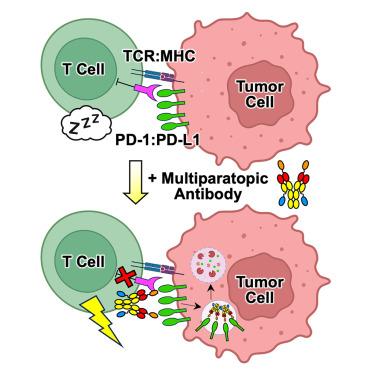Cell Chemical Biology ( IF 8.6 ) Pub Date : 2024-03-27 , DOI: 10.1016/j.chembiol.2024.02.014 Seth D. Ludwig , Bunyarit Meksiriporn , Jiacheng Tan , Rakeeb Kureshi , Akhilesh Mishra , Kyle J. Kaeo , Angela Zhu , Georgia Stavrakis , Stephen J. Lee , David. J. Schodt , Michael J. Wester , Dhiraj Kumar , Keith A. Lidke , Andrea L. Cox , Helen M. Dooley , Sridhar Nimmagadda , Jamie B. Spangler

|
Programmed death-ligand 1 (PD-L1) drives inhibition of antigen-specific T cell responses through engagement of its receptor programmed death-1 (PD-1) on activated T cells. Overexpression of these immune checkpoint proteins in the tumor microenvironment has motivated the design of targeted antibodies that disrupt this interaction. Despite clinical success of these antibodies, response rates remain low, necessitating novel approaches to enhance performance. Here, we report the development of antibody fusion proteins that block immune checkpoint pathways through a distinct mechanism targeting molecular trafficking. By engaging multiple receptor epitopes on PD-L1, our engineered multiparatopic antibodies induce rapid clustering, internalization, and degradation in an epitope- and topology-dependent manner. The complementary mechanisms of ligand blockade and receptor downregulation led to more durable immune cell activation and dramatically reduced PD-L1 availability in mouse tumors. Collectively, these multiparatopic antibodies offer mechanistic insight into immune checkpoint protein trafficking and how it may be manipulated to reprogram immune outcomes.
中文翻译:

多互补位抗体诱导程序性死亡配体 1 的靶向下调
程序性死亡配体 1 (PD-L1) 通过其受体程序性死亡-1 (PD-1) 与活化的 T 细胞结合,驱动对抗原特异性 T 细胞反应的抑制。这些免疫检查点蛋白在肿瘤微环境中的过度表达促使人们设计出破坏这种相互作用的靶向抗体。尽管这些抗体在临床上取得了成功,但缓解率仍然很低,需要新的方法来提高性能。在这里,我们报告了抗体融合蛋白的开发,该蛋白通过一种针对分子运输的独特机制来阻断免疫检查点途径。通过结合 PD-L1 上的多个受体表位,我们的工程多互补位抗体以表位和拓扑依赖性方式诱导快速聚类、内化和降解。配体阻断和受体下调的互补机制导致更持久的免疫细胞激活,并显着降低小鼠肿瘤中 PD-L1 的可用性。总的来说,这些多互补位抗体为免疫检查点蛋白运输以及如何操纵它来重新编程免疫结果提供了机制见解。































 京公网安备 11010802027423号
京公网安备 11010802027423号